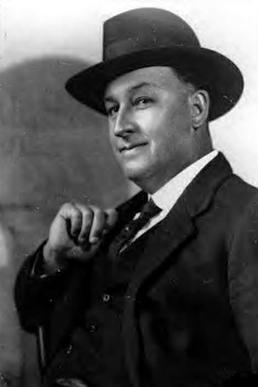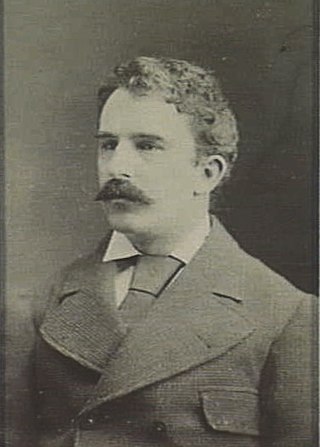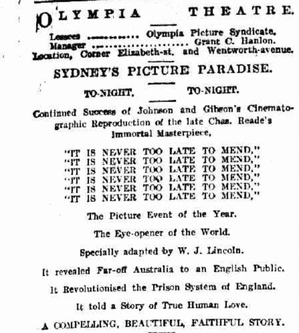
For the Term of His Natural Life is a story written by Marcus Clarke and published in The Australian Journal between 1870 and 1872. It was published as a novel in 1874 and is the best known novelisation of life as a convict in early Australian history. At times relying on seemingly implausible coincidences, the story follows the fortunes of Rufus Dawes, a young man transported for a murder that he did not commit. The book clearly conveys the harsh and inhumane treatment meted out to the convicts, some of whom were transported for relatively minor crimes, and graphically describes the conditions the convicts experienced. The novel was based on research by the author as well as a visit to the penal settlement of Port Arthur, Tasmania.
For the Term of His Natural Life is a 1927 Australian film based on the 1874 novel by Marcus Clarke, directed, produced and co-written by Norman Dawn. It was the most expensive Australian silent film ever made and remains one of the most famous Australian films of the silent era.

Raymond Longford was a prolific Australian film director, writer, producer, and actor during the silent era. Longford was a major director of the silent film era of the Australian cinema. He formed a production team with Lottie Lyell. His contributions to Australian cinema with his ongoing collaborations with Lyell, including The Sentimental Bloke (1919) and The Blue Mountains Mystery (1921), prompted the Australian Film Institute's AFI Raymond Longford Award, inaugurated in 1968, to be named in his honour.

Alfred Dampier was an English-born actor-manager and playwright, active in Australia.

Alfred Rolfe, real name Alfred Roker, was an Australian stage and film director and actor, best known for being the son-in-law of the celebrated actor-manager Alfred Dampier, with whom he appeared frequently on stage, and for his prolific output as a director during Australia's silent era, including Captain Midnight, the Bush King (1911), Captain Starlight, or Gentleman of the Road (1911) and The Hero of the Dardanelles (1915). Only one of his films as director survives today.

It Is Never Too Late to Mend is a 1911 Australian feature-length silent film written and directed by W. J. Lincoln.

The Double Event is a 1911 Australian feature-length film directed by W. J. Lincoln based on the first novel by Nat Gould, which had been adapted several times for the stage, notably by Bland Holt.
The MacMahon brothers were entrepreneurs in Australian show business. Chief among them were James MacMahon and Charles MacMahon, who together and separately toured a large number of stage shows. Their younger brothers, Joseph and William, were involved in many of those activities.

Captain Midnight, the Bush King is a 1911 Australian silent Western film about the fictitious bushranger Captain Midnight. It was the directorial debut of actor Alfred Rolfe. The film is based on the play of same name by W. J. Lincoln and Alfred Dampier. Captain Midnight, the Bush King is now considered lost.
The Life of Rufus Dawes is a 1911 Australian silent film based on Alfred Dampier's stage adaptation of the 1874 novel For the Term of His Natural Life produced by Charles Cozens Spencer.

The Lady Outlaw is a 1911 Australian silent film set in Van Diemen's Land during convict days.
The Cup Winner is a 1911 Australian silent film directed by Alfred Rolfe. It is set against a backdrop of horseracing and the finale involves real footage from the 1911 Melbourne Cup.
The Waybacks is a 1918 Australian silent film directed by Arthur W. Sterry. It is a rural comedy in the vein of Dad and Dave based on a play adaptation of a series of popular novels. Only part of the film survives today.
Ernest Henry Higgins was an Australian cinematographer during the days of silent film. He was the eldest brother of Arthur and Tasman Higgins. He shot the film The Throwback (1920) for director Arthur Shirley which resulted in Shirley unsuccessfully suing Higgins for breach of contract.

Jessica Harcourt (1905–1988) was an Australian mannequin, author and actress, best known for playing a leading role in For the Term of His Natural Life (1927).
Hartney J. Arthur was an Australian actor, writer and film director, who worked in stage, radio and film.
For the Term of His Natural Life is a 1983 Australian three-part, six-hour television miniseries based on the classic 1874 novel of the same name by Marcus Clarke. Each episode aired for two hours on Nine Network on 23 May, 30 May and 6 June 1983.
A convict melodrama is a type of melodrama set in Australia during the convict era. They normally revolved around stories of innocent people wrongly accused of a crime who were transported to Australia as convicts. The best known work in this field was the novel For the Term of His Natural Life, which was adapted into various plays and films.

Edward Irham Cole was an Australian theatrical entrepreneur and film director whose productions represented a synthesis of Wild West show and stage melodrama. He managed a theatre company, called the Bohemian Dramatic Company, that performed in semi-permanent and temporary tent theatres. During 1910 and 1911 Cole directed a number of silent films, adapted from his stage plays and using actors from his theatre company.
For the Term of His Natural Life is an 1886 Australian stage play adaptation of the novel For the Term of His Natural Life.










